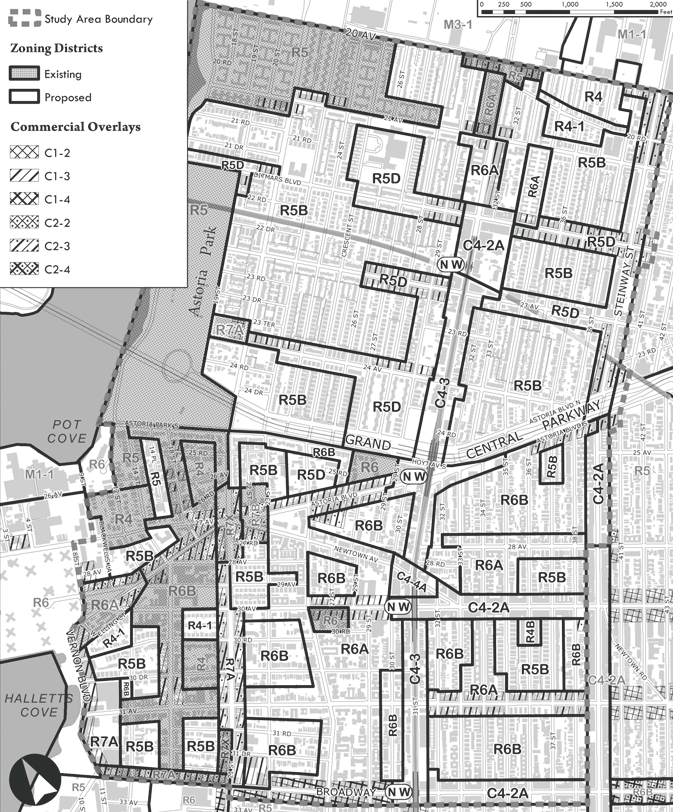Local Council Member and residents supported the proposed 248-block contextual rezoning, but two property owners requested modifications. On March 24, 2010, the City Planning Commission heard testimony on the Department of City Planning’s contextual rezoning plan for Astoria, Queens. The 248-block study area is generally bounded by 20th Avenue to the north, Broadway to the south, Steinway Street to the east, Vernon Boulevard and the East River to the west, and is divided by the Grand Central Parkway. The proposal builds on three smaller rezonings adopted in the area between 1989 and 2001.
The majority of the area’s northern blocks are currently zoned R5 and characterized by two- and three-story rowhouses and semi-detached homes with consistent building heights and front yards. The area’s southern blocks are predominantly zoned R6 and characterized by large prewar apartment buildings between three and seven stories tall. There are no established height limits in R6 zoning districts, and the maximum FAR for residential uses is 2.43 while community facility uses are permitted to build up to a maximum of 4.8 FAR. As a result, the area has recently experienced development out-of-scale with the neighborhood’s built character.
The plan would replace the existing zoning with contextual zoning districts in order to establish height limits in lower-density areas and encourage the development of housing along the area’s wide streets. Planning’s proposal includes rezoning 125 blocks to R5B, establishing a maximum building height of 33 feet to match the block’s semi-detached and two- and three-story attached homes. Sixty northern blocks would be rezoned to R5D to match the three- and four-story buildings found in the area. To the south, portions of 48 blocks would be rezoned to R6B, permitting all housing types and reflecting the three- and five-story residential buildings that characterize the area. In order to provide new commercial opportunities in the area, the plan would apply commercial zoning districts to portions of 67 blocks, including the 31st Street corridor, which features the elevated N and W subway lines. The Inclusionary Housing Program’s provisions would apply to sixteen blocks proposed to be rezoned to R7A and C4-4A.
At the hearing, a representative for Council Member Peter Vallone, whose district includes Astoria, said Vallone had requested a rezoning study five years ago in order to combat the area’s out-of-character development and that he fully supported the current proposal. Donnelly Marks, representing Astoria’s Norwood Neighborhood Association, testified that developers in recent years had “pushed the R6 envelope” and abused the current zoning’s community facility “loophole” to
overbuild. Marks said the group fully supported Planning’s “balanced and smart” rezoning proposal. Two property owners requested that the Commission modify the plan. Attorney Jordan Most, representing the owner of an industrial building at 35-10 Astoria Boulevard South that would be rezoned from R6 to R6B, asked the Commission instead to include the property in the proposed C4-3 district immediately west of the site. Most said the owner’s business would still be a legal nonconforming use, but the property would not be as attractive to future commercial tenants with an R6B designation.
John Kaiteris, the executive director of HANAC Inc., an affordable housing developer that plans to build a nine-story senior housing facility at 31-30 33rd Street, requested that the Commission exclude their site from the proposal. Kaiteris said that under the proposed R6B zoning the organization would be limited to a four-story building. HANAC had only recently approached Planning with these concerns, and Chair Burden pointed out that Planning had conducted extensive community outreach over the past year. Kaiteris explained that HANAC had been focused on obtaining the project’s federal funding and that somehow the proposal bypassed the group.
The Commission has until May 21, 2010 to vote on the rezoning.
CPC: Hearing on Astoria Rezoning and Text Amendment (C 100199 ZMQ – rezoning); (N 100200 ZRQ – text amend.) (March 24, 2010).


